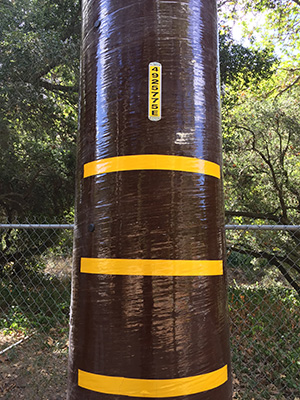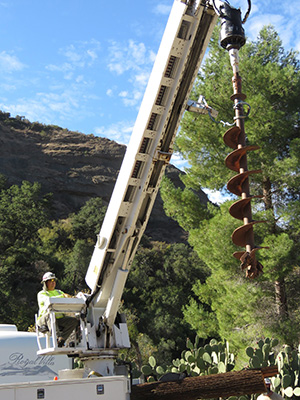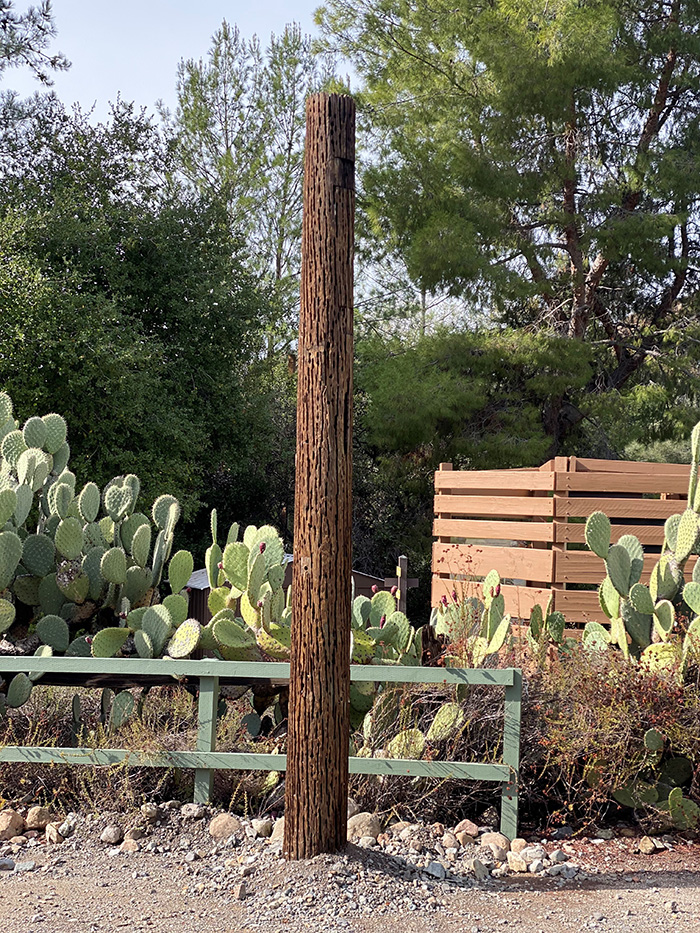Acorn Woodpeckers in Silverado, CA get help from Southern California Edison Electric Company
by Gilllian Martin
 Photo by Peggy Honda
Photo by Peggy HondaThe remote, two-lane Modjeska Canyon Road in Silverado, California curves through grand old oaks and sycamores that splatter it with dappled light. Engineers appear to have contoured the road to accommodate a few of them; a commendable recognition that this territory is long held by Nature and deserves respect. The trees and steep walls of the canyon invite serenity and provide privacy. It’s no surprise that urban-weary Californians covet living here.
Occasionally, the voice of a charismatic bird, the Acorn Woodpecker, breaks from the trees. Waka-waka-waka. It signals that humans alone don’t claim the canyon. For unmeasured time these birds have lived here in large numbers, dependent on the acorns produced by the oaks and the presence of dead trees suitable for excavating nesting cavities. If Nature had an avian icon of the canyon, it would be this woodpecker. But their future is worrisome. Fire authorities and Edison Electric have important priories here that conflict with their needs. To understand the challenges, it’s helpful to better understand the bird.
 Like other woodpeckers, they not only raise their young in cavities in dead trees but opportunistically in wooden power line poles. What’s unique to the species is the habit of also using the trees and poles to store acorns as food for their families in fall and winter. These storage sites are referred to as granaries. Some contain many thousands of acorns. The woodpeckers’ presence is key to the ability of other cavity nesting birds to breed here because their abandoned nest sites are inherited by screech-owls and songbirds which cannot excavate their own.
Like other woodpeckers, they not only raise their young in cavities in dead trees but opportunistically in wooden power line poles. What’s unique to the species is the habit of also using the trees and poles to store acorns as food for their families in fall and winter. These storage sites are referred to as granaries. Some contain many thousands of acorns. The woodpeckers’ presence is key to the ability of other cavity nesting birds to breed here because their abandoned nest sites are inherited by screech-owls and songbirds which cannot excavate their own.
 Photo by Julie Williams
Photo by Julie Williams Here’s where the challenge emerges. The canyon is a high-fire-risk zone; a frightening fact for its residents, and a problem for the woodpeckers, but for different reasons. Human safety and protection of property must come first, so fire authorities order dead trees, dead limbs in live trees, and downed wood within 100 feet of human structures removed. Edison is also replacing wood power line poles with metal ones. The canyon is home to Tucker Wildlife Sanctuary. Its Site Manager, Marcella Gilchrist, recognizes the loss of habitat for the birds and is further concerned that they may soon start using the siding on homes to store their acorns. The question is, will the nature-loving residents of the canyon now start seeing the birds as foes?
 Photo by Julie Williams
Photo by Julie Williams Hope of saving these power pole granaries seemed remote until November of this year when we contacted Edison’s Avian Program Manager, Kara Donohue, to inquire if a pole they recently removed could be re-installed on the Sanctuary’s property. Her answer was encouraging. A site visit was arranged to discuss a new location. Then, with the help of an Operations Supervisor, Robert Maystrovich, and their legal team, the necessary papers were drawn up to allow ownership and responsibility for the pole to be transferred to the Sanctuary. Shortly after, a crew of four arrived with the necessary equipment and installed the pole just yards from its original location. No charge! Within a couple of weeks, the Sanctuary’s volunteers joyfully reported that the woodpeckers were using it. Other poles on this road are slated for removal, but thankfully not all are granaries. The hope is that when circumstances are favorable, additional relocations may be possible.
The larger challenge remains, of course. The birds need dead trees. Marcella believes they have found some higher up on the surrounding hills. Meanwhile other wildlife that benefit from the features of dead trees and insect prey within them must also try to eek out an existence elsewhere. For how long they and the woodpeckers will be successful is unknown.
The habitat value of natural areas like this canyon are steadily lost to human occupation, and climate change accelerates fire frequency. If it weren’t for human occupation fire might be permitted to run its course and deliver regenerative benefits long-designed by Nature. Time cannot be reversed. However, even if actions like those of Edison in this case are small, we know that cumulatively they can help ecosystems like this one from collapsing. We also know that when professionals are hired to take care of trees, especially large, old specimens that are prone to failure, they may have a better life expectancy and ability to serve Nature. But it requires a property owner to hire qualified people and ask the question, ‘Does the tree need to be removed completely?’ The power is in our hands. When thinking about retaining a dead tree, there are several considerations and options. This decision model may be helpful.



Connect
Connect with us on the following social media platforms.